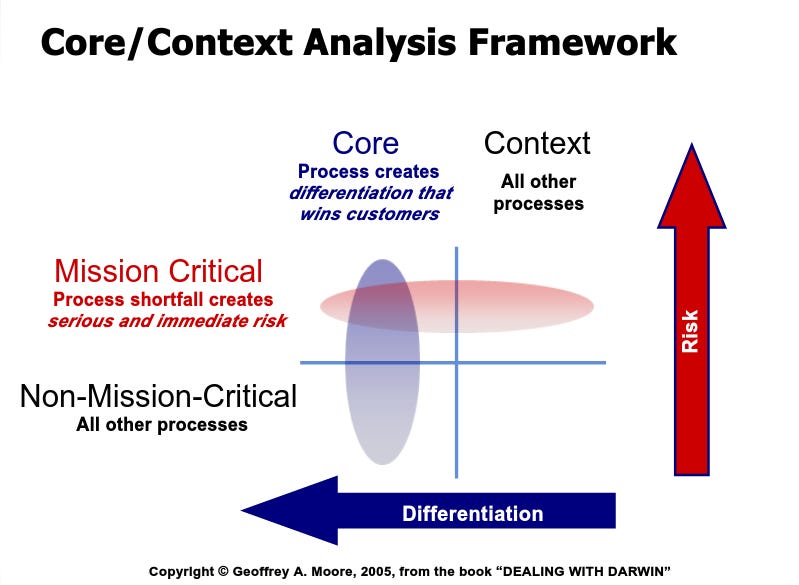Back in 2005, Geoffrey Moore introduced in his book Dealing with Darwin a deceptively simple model that helped shape how organizations think about focus: Core vs. Context. It became a useful resource in strategic planning sessions, boardroom decks, and org design discussions.
At its heart, the model divides all business activities into two buckets:
- Core: The things that make you you. These are the differentiating capabilities that give your organization a competitive edge. If your customers choose you over the competition for a specific reason, that reason is core.
- Context: Everything else. These are the necessary, often unavoidable, activities that keep the business running but don’t set you apart. Think payroll, IT support, HR administration, compliance, they’re all vital, none differentiating.

Moore’s advice was straightforward yet powerful: focus your internal energy on Core: nurture it, invest in it, protect it. Meanwhile, find efficient ways to handle Context often by outsourcing, automating, or standardizing it.
This mental model became a useful lens for leaders trying to decide what to build in-house, what to outsource, and where to invest limited resources. It helped make the invisible visible: just because a task is urgent doesn’t mean it’s strategic.
But here’s the twist: Moore’s framework assumed a world where humans (and their organizations) were the primary doers. Today, that assumption no longer holds.
The Rise of Agentic Work
Fast forward to today, and we’re in a radically different landscape. We’re not just automating tasks anymore; we’re handing off goals.
Thanks to advances in AI, especially the emergence of autonomous and semi-autonomous agents, we now have software that can plan, decide, and act with a surprising degree of independence. These aren’t just tools waiting for human input. They take initiative, respond to changing conditions, and in some cases, coordinate with each other or with humans to get things done. This capability is accelerating, especially with the rise of standard interaction protocols such as MCP.
Think AI agents that:
- Monitor customer feedback and open support tickets automatically
- Manage marketing campaigns, adjusting content and spend based on live results
- Research, draft, and summarize documents based on loose goals
- Analyze internal data to recommend (or even trigger) process improvements
These agents are crossing a boundary. They’re no longer just augmenting human work. They’re starting to own chunks of it.
Which brings us to the big strategic question:
Where do AI agents belong in the Core vs Context model?
Should they be treated like an outsourcing layer as a smarter, faster way to handle context work? Or can they play a role in the core contributing to the activities that differentiate us?
Or perhaps they’re something else entirely: a new kind of actor. A third pillar.
Updating the Model: Core, Context, and the Rise of Delegation
So how should we think about AI agents in the Core vs Context framework?
Here’s one way I believe we could evolve the model:
We keep the original distinction, but introduce a new layer of agentic involvement, considering the level of autonomy or collaboration model assumed by AI agents within the model’s quadrants.
1. Context Offloading (with Human-in-the-Loop)
Much of the “Context” category consists of essential but non-differentiating work such as generating reports, handling internal documentation, processing support tickets, chasing routine approvals ,etc.
These aren’t the areas where companies win in the market but they do take up time, and often a lot of human energy.
With AI agents, we have a new opportunity: offload the predictable parts of this work, while elevating the people currently doing it to higher-value roles.
Instead of running through a checklist manually, a team member becomes the one who monitors, validates, and refines the agent’s output.
Instead of writing reports from scratch, they ensure the generated version is accurate, contextualized, and aligned with business goals.
In short: humans aren’t being replaced , they’re being repositioned as supervisors and orchestrators of agentic workflows.
This shift opens up time and mental space for more strategic thinking, problem-solving, and cross-functional collaboration.
That said, it’s important not to treat this as a clean handoff. Not all context roles map neatly to agent supervision, and not every team will be ready culturally or structurally to adapt overnight. There’s real organizational inertia to overcome: process silos, misaligned incentives, and natural skepticism about “AI theater” (where automation is more optics than outcome). Offloading work to agents isn’t just a technical decision. it’s a change management challenge. It requires rethinking roles, retraining teams, and re-earning trust in how decisions are made and validated.
2. Core Augmentation (Human-Led, AI-Enabled)
In core work (the stuff that makes your business different) human creativity remains central. But AI agents can still play a powerful supporting role.
Here, agents act as:
- Research assistants who surface insights at speed
- Creative sparring partners who generate fresh angles or variations
- Task accelerators who take care of the groundwork so humans can focus on synthesis and strategy
Importantly, humans remain the authors of originality, the stewards of brand and culture, and the ones who connect dots in unexpected ways. AI isn’t replacing core work, it’s expanding what’s possible within it.
3. A New Strategic Lens
With this reframed model, you get a more adaptive map for the age of agentic work:
- Core → Human-led, agent-augmented
- Context → Agent-executed, human-supervised
- Your job as a leader → Constantly reevaluate what belongs where
Because here’s the catch: the boundary between core and context is fluid.
A task that’s context in one organization might be core in another — especially if AI is involved in a novel way. And what seems like a routine task today might become a source of differentiation tomorrow, if approached creatively.
The model still works. But now it demands ongoing attention, deliberate delegation, and a clear-eyed view of where humans add the most value.

So, What Now? Rethinking Work in an Agentic Era
Adapting the Core vs Context model for the age of AI agents isn’t just a strategic exercise; it’s an invitation to rethink how we design work itself.
Leaders should start asking new questions:
- What tasks are we doing today that could be supervised rather than executed?
- Where are our people bogged down by context and how might agents help them rise above it?
- How do we create space for our teams to lead creatively, not just operate efficiently?
And at the individual level:
- If part of your role feels like repeatable context, how could you evolve into the agent’s coach, validator, or integrator?
- If you’re doing core work, how might an agent push you into new creative territory?
This isn’t about humans vs. AI. It’s about humans with AI, working differently.
AI agents are the new interns, copilots, research aides, and systems thinkers. But we’re still the ones setting the goals, making the calls, and deciding what matters.
The companies that adapt fastest won’t be the ones that automate the most; they’ll be the ones that delegate the smartest, using agents to clear space for better thinking, faster learning, and more meaningful work.
Moore’s model helped us focus.
Now it could also help us evolve and incorporate agentic work shaping the (imminent)future of work.


